Peter Pan (PG)
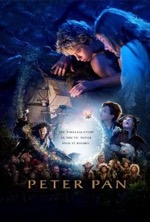
Starring: Jeremy Sumpter
December 2003
“Return to a Dry Well”
Acting:
This new, live-action spin on J.M. Barrie’s classic tale, Peter Pan boasts a solid cast of virtually unknown actors. Two performances stand out above the others; Jeremy Sumpter, who plays the title role and Jason Isaacs, whose dual role as Mr. Darling and Captain Hook is one of the few highlights of the movie. From a dramatic standpoint, this new movie features the best version of Hook ever committed to film—Isaacs’ portrayal of the sinister pirate captain is darker and subtler than any previous attempt, but the petulant Hook in Disney’s animated Peter Pan and Dustin Hoffman’s scheming and foreboding figure in Hook were both more amusing and more memorable than this year’s model.
Director:
Who the heck is P.J. Hogan?
Screenplay/Story:
The big question is, “Why do we need another remake of this story?” We have the aforementioned Disney’s Peter Pan and Hook, and the recent straight-to-video flop, “Return to Neverland,” plus a cartoon series in the early nineties and a slew of story variations on stage. Truth is, it’s been done before and it’s been done better. There are only a few story elements that don’t come off like stale toast (or crumpets). There’s a nice touch at the beginning of the movie when Mr. Darling tries to impress his boss and bumbles all over himself—quite amusing. The reunion of the Darling children with their mother at the end of the movie packs a surprisingly emotional punch and is probably the most touching dénouement of any Peter Pan.
Special Effects:
There’s a very creative scene where Peter and the Darling children are spying on the Jolly Roger from up in the clouds and the pirate ship starts firing cannon balls through the clouds—great visual. The worst effect in the film is Hook’s bane; the crocodile’s movements look extremely unbelievable and unnatural in this shoddy piece of CGI. The best, and most beautiful, effect in the movie is in the forest, where an entire community of ferries dance and flit about like fireflies against the night sky.
Final Analysis:
If we ever return to Neverland, it will be far too soon.
Rating: 2
Paycheck (PG-13)
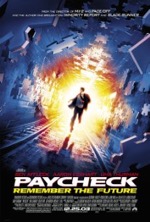
Starring: Ben Affleck
December 2003
“Futuristic Thriller With a Twist”
Part spy thriller, part sci-fi movie, “Paycheck” is one hundred percent action flick that starts out at a fevered pitch and never slows down. Based on a short story by Phillip K. Dick (Blade Runner), “Paycheck” introduces an inventive, yet disturbing, vision of the future; a “what if” scenario. What if highly trained computer experts and bio-engineers were implanted with a marker at the beginning of a top-secret project and, when the job was completed, their memories were wiped all the way back to the point of marker insertion? What if you lost three years of your life (memories), but received remuneration for your services somewhere in the ballpark of eight figures? But what if the project you worked on was illegal, and the F.B.I. shows up and you have no memory of what you’ve been doing for the last three years?
Michael Jennings (Ben Affleck) is on the run from his former employer and the feds., and all he has to aid him in his search for answers to the past is a manila envelope filled with a dozen ordinary items that he had the foresight to send himself before the memory wipe. A latent memory of a significant other leads Michael to Rachel (Uma Thurman), the one person who can help him get back into the lab and destroy the machine that he built…a device that will lead to great catastrophe in the future.
Oversimplified? Far-fetched? A bit confusing? You bet! But if “Paycheck” has any redeeming quality, it’s that it doesn’t linger in one place too long. John Woo (Mission Impossible 2) does a good job of building intensity and sprinkling in action sequences at appropriate times until the explosion-filled climax.
Ben Affleck has tried his hand at being the lead in a thriller before (The Sum of All Fears), but his low-key—almost passionless—portrayals will prevent him from becoming an action star for the foreseeable future. Uma Thurman, a fairly well respected actress in drama, comedy and action circles adds very little to the movie—her vanilla performance will be forgotten shortly after the movie vacates theaters.
Even with mediocre elements, “Paycheck” somehow, inexplicably, manages to become more than the sum of its parts. This is, undoubtedly, due in large part to the genius of the source material the movie draws upon, proving once again that a slightly above average story can bail out average performances. “Paycheck” is a good popcorn movie that works great after you’ve suspended your disbelief, and works even better when you’ve only paid the matinee price.
Rating: 2 1/2
The Lord of the Rings: The Return of the King (PG-13)

Starring: Elijah Wood
December 2003
“Triumphant Finale of Modern Masterpiece”
The word “triumph” hardly seems to suffice when used to describe the stupendous achievement that is The Return of the King, the third and final chapter in the Lord of the Rings trilogy. The battles are bigger, the stakes are higher and emotions run deeper in this installment, which was labeled a modern classic by movie critics even before the film was released. Some would call that kind of buzz a heady brand of Hollywood hype. The problem with hype is it seldom lives up to its billing or to the audiences’ expectations. Hype for The Return of the King, however; is like holding a postcard from Disneyland, whereas the movie itself is like an exhilarating day of non-stop rides inside the real park.
Picking up right where The Two Towers left off, The Return of the King forges ahead with multiple plot lines, a device that auteur Peter Jackson masterfully employed in the middle film. Sideline Hobbits Merry (Dominic Monaghan) and Pippin (Billy Boyd) are finally elevated from comic relief status and actually figure prominently in the film’s major battle. The wizard, Gandalf (Ian McKellen) is, again, underserved, but makes the most of his meager screen time; dispensing wit and wisdom with ease and demonstrating the battlefield prowess of a fierce warrior. Legolas (Orlando Bloom) and Gimli’s (John Rhys-Davies) friendship continues to deepen and is a genuine and heart-warming example of racial reconciliation. There are so many other wonderful characters (Bernard Hill’s Theoden and Miranda Otto’s Eowyn, just to name two) that give color and texture to the Tolkien/Jackson canvas, but the heart of the story involves Aragorn’s (Viggo Mortensen) claim to the throne and Frodo (Elijah Wood), Sam (Sean Astin) and Gollum’s (Andy Serkis) fateful journey to Mt. Doom; the only place in Middle-earth where the surpassingly evil “one ring” can be destroyed.
Aragorn has finally arrived in this film; he has clarity of purpose and a sense of urgency and resolve previously unseen in the trilogy. Armed with newfound gravitas, Aragorn flexes his royal muscles in two key moments: 1. He doesn’t take no for an answer when conscripting the aid of the Army of the Dead, and 2. He delivers a rousing, courageous and honor-inducing speech (the kind that would make you follow him over a cliff if he requested it) when leading his army against the hoards of orcs assembled at the foreboding Black Gate.
The technical aspects of the movie are nothing short of miraculous (The Battle of Pelennor Fields makes Helm’s Deep look like recess), but as with the other two pictures, dazzling effects don’t upstage the actors or the struggles their characters face—Jackson, again, brilliantly balances the epic and the intimate in seamless, yet impacting, ways. And this is nowhere more evident than with the bound-by-fate ménage a trios of Frodo, Sam and Gollum. Here is the real vertex—the focal point—of the entire expansive tale. The trio’s flight into the heart of disheartening Mordor brings attitudes and motives to a head: Sam’s escalating distrust of Gollum, Frodo’s increasing vulnerability to the will of the ring and Gollum’s scheming ways and ever-present lust to reclaim his precious. Forget about the battle between orcs and men, this is the real conflict in the movie.
These scenes have many nuggets that lay just beneath the surface: ineffable motivations, telling glances and subtext between characters that speaks volumes in the absence of any actual dialogue. Case in point; somewhere in the arduous journey it becomes clear that Sam, not Frodo, is the true hero of this sprawling epic. Also, there is tremendous spiritual significance to Gollum’s fateful plunge into the sea of fire—the symbolism between the enticements of the ring and evil’s alluring nature will likely never be captured in a more poignant tableau.
There are several emotionally-charged scenes near the end of the film; a coronation, a reunion of lovers and many farewells, but perhaps the most touching moment is when King Aragorn, and the rest of his kingdom, kneels in abeyance to the four Hobbits—a fitting fulfillment of Galadriel’s prior prophetic statement, “Even the smallest person can change the course of the future.” And in unique ways, each of the Hobbits has played a vital role in the coda of Tolkien’s masterpiece. And in his diminutive, Hobbit-like way, Jackson has also left his indelible mark on the future of motion pictures—will the symbolism ever end?
Only two things come to mind as negative aspects of the film: 1. There is only a hint of the romance between Faramir and Eowyn—as chronicled in the book (perhaps this relationship will be fleshed out in the imminent Extended Edition of the film), and 2. The movie’s wrap-up drags on a bit too long and certainly isn’t aided by a series of mock endings.
The Return of the King is destined to garner multiple Academy Awards and seems positioned to make a solid bid for best director and best picture. Despite all of its many accolades, however, some would still choose to label The Lord of the Rings as nothing more than glorified sword and sorcery, a child’s tale…not to be taken seriously. But make no mistake, The Return of the King is high art in fantasy trappings. The king of all movies/trilogies has finally arrived.
Rated: 3 1/2
Timeline (PG-13)
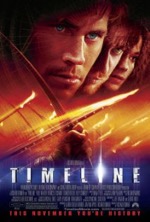
Starring: Paul Walker
November 2003
“Mediocre Romp Through Time”
A faithful (if greatly abridged) adaptation of Michael Crichton’s novel of the same name, Timeline is a fun, popcorn movie that entertains but doesn’t trick you into thinking that it’s a major blockbuster hit…because it’s not. It is, however, a great way to get lost in the past for two hours.
The story breaks down like this: a well-financed tech company (ITC) has discovered a way to send someone back in time. Professor Johnston is trapped in France in the year 1357, and it’s up to his son, Chris, and Chris’ history-buff companions to rescue the professor from a life in the past. To add tension and urgency to their quest, the team only has six hours to retrieve the professor before they are automatically returned to the present day. And, to make matters worse, the group arrives on the day of a massive battle between the English and French armies, and they’re trapped on the loosing side.
There’s no one area of Timeline that’s spectacular, but as a whole, the movie works quite well. The acting is decent, though most of the faces are unfamiliar, save for Paul Walker (2 Fast 2 Furious) and Neil McDonough (Minority Report). The historical costumes, sets and props all look authentic and the directing by Richard Donner (Lethal Weapon) is deft; though, the movie lags in a couple of places. The ending battle sequences are excellent, revealing the more visceral side of combat in the fourteenth century—the catapult shots and flaming arrow scenes were riveting.
If there’s a downside to Timeline, it’s the cursory character development and lack of scientific explanations with regard to the time machine. Granted, there isn’t enough time in a two hour movie to delve into every aspect of how the time machine was built and operates, but the fact that it does exist is treated in such a “by the way” manner that it diminishes its role in the movie and undermines the credibility of the movie as a whole.
In the novel, Crichton takes the time to give a point-by-point explanation of the machine and the science that governs it—the idea of faxing a copy of a person back in time is absolutely brilliant. In the movie, however, that concept is only hinted at and the writers, instead, have chosen to use a wormhole attuned to 1357 as the conduit for transportation to the past. Since the method of time travel is vague and confusing, it’s hard to buy into anything that happens in the past, and that’s the major problem with Timeline. With the complexity of the science involved and a larger ensemble of characters to develop, this is probably one Crichton novel that shouldn’t have been translated into a movie. I suppose time will tell.
Rating: 2 1/2
The Haunted Mansion (PG)
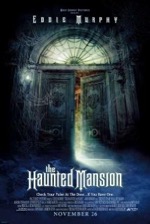
Starring: Eddie Murphy
November 2003
“Too Scary, Not Very Funny”
Based on the classic ride at Disneyland, The Haunted Mansion is a scare-fest that feels more like a glorified attraction than a movie. The scenes, symbols and inside gags from the ride are all here, but The Haunted Mansion seems more like a caricature of itself than a living, breathing entity.
The movie opens with overachieving real estate agent, Jim Evers (Eddie Murphy) visiting a mansion with his wife and two kids. They are met at the front door by a creepy butler named Ramsley, who promptly and unceremoniously escorts the family through the dusty, cobweb-ridden halls to meet his master. Master Gracey is a tortured soul, a shadowy figure who pines over the loss of his wife, Elizabeth, a woman who had a striking resemblance to Evers’ wife.
Things go south when Evers discovers Ramsley’s plot to unite Gracey and Evers’ wife in matrimony in order to break an age-old curse. Evers must brave flying instruments, a haunted graveyard and many other frightening things before he can attempt to thwart the butler’s sinister plan.
The Haunted Mansion is the third movie based on a Disneyland attraction, and is arguably the biggest disappointment of the lot. The trailer promises a light and comical joyride, but the actual movie is much darker in tone and isn’t all that funny. When it comes to jokes and humorous dialogue, there’s nothing fresh in Murphy’s repertoire; in fact, his one-liners come off like the donkey gags in Shrek.
The acting is appropriate in The Haunted Mansion, especially the ubiquitous and nefarious Ramsley (Terence Stamp), and the pathos-inducing Master Gracey (Nathaniel Parker). The face in the crystal ball, Madame Leota (Jennifer Tilly), offers some much needed comic relief and she and Murphy’s character play off of each other quite well.
The special effects are top-notch—as would be expected from Disney—but they overshadow the story, stifle character development and suppress any human element in the story, save for the Beauty and the Beast style storybook ending. In the final analysis, The Haunted Mansion is nothing more than a two-hour, live-action version of the Disneyland ride. In fact, the movie resembles the attraction so closely that after you leave the theater, you realize the thrills, chills and spills have been grossly artificial and that you’ve been taken for a ride.
Rating: 2
Master and Commander: The Far Side of the World (PG-13)
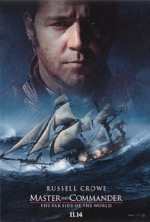
Starring: Russell Crowe
November 2003
“Intelligent Adventure on the High Seas”
In addition to having a long title, Master and Commander is a lengthy film, but is well worth the voyage. The movie is adapted from the first and tenth books in a twenty book series written by Patrick O’Brian, and stars Russell Crowe, who plays Captain “Lucky” Jack Aubrey. Set in 1803, during the Napoleonic Wars, the story captures the gritty realism of life and death on the high seas when naval vessels determined the fate of king and country.
Aubrey, commander of the H.M.S. Surprise, receives orders to pursue and sink the French frigate, Acheron, a vessel with double the hull thickness as the Surprise, which can also outrun and outgun Aubrey’s ship. In an ironic twist, the Surprise is caught off-guard in the movie’s prologue. What ensues is a borderline-obsessive pursuit of the French ship and its wily captain. Several unexpected twists lead up to the battle royal, which decides the outcome of Aubrey’s hell bent mission.
Crowe excels in his portrayal of Captain Aubrey, a character who could easily have been painted with broad, Ahab-like strokes, but remains wholly human—almost vulnerable at times. It has been said that command and compassion is a fool’s mixture, but Aubrey balances both of these attributes in an effective manner: he is honor-bound and resolute, but he also has a wonderful sense of humor and a great camaraderie with his crew.
In assessing Crowe’s performance, the word “natural” immediately comes to mind. Crowe has the uncanny ability to take the leading role in any of these modern epics (Gladiator) and make it his own—seamlessly merging his personality with that of the character he portrays. Joining him on the cruise is Dr. Stephen Maturin, played by Paul Bettany, who also portrayed Crowe’s imaginary roommate in the Academy Award winning, A Beautiful Mind. Maturin is the constant voice of reason in the film and he is both friend and foil to Aubrey. Among the other faces in the crew is Billy Boyd (The Lord of the Rings trilogy), whose turn as a scarred and weatherworn sailor is quite a departure from his role as Pippin the Hobbit.
One of the major driving forces behind Master and Commander is director Peter Weir (Dead Poets Society and The Truman Show), who also co-wrote the screenplay and co-produced the movie. Weir does a wonderful job of capturing the flavor of the early 1800s, while steering clear of any anachronisms—elements out of place or time that seem to mar every other period film that comes out of Hollywood these days. The soundtrack by Iva Davies, Christopher Gordon and Richard Tognetti is sweeping and elegant, brilliantly weaving classical standards into their original score.
The only downside to the film, is that it drags on a bit at times and gradually induces seasickness in the viewer—it isn’t until about the two hour mark that the crew finally steps onto dry land (the pristine Galapagos Islands). Master and Commander is a mature and intelligent sea battle film that, thanks to great acting and directing, is shipshape and Bristol fashion.
Rating: 3
Brother Bear (G)

Starring: Joaquin Phoenix
November 2003
“Hackneyed, but Still Heartwarming”
I’ve never been a big fan of talking animal pictures, but Disney has an uncanny knack for making such films not only palatable, but also feasible in most respects. The moment I learned Disney’s Dinosaur (2000) was going to feature talking prehistoric creatures, I thought for sure it would be a flop…I was wrong. Though produced by a different studio, Ice Age, also featuring talking animals from the distant past, surpassed my expectations as well.
So along traipses Brother Bear, an unassuming animal animated feature, which has been reported as the final traditionally hand-drawn animated feature film for Disney (is this true?). Though a bit heavy on the “ancestral spirits,” Brother Bear is heartwarming and has a good message.
Set in the Pacific Northwest, long before Europeans settled in the Americas, Brother Bear is the story of three brothers: Sitka (oldest), Denahi and Kenai (voiced by Joaquin Phoenix). Kenai needs to fulfill a ritual in order to become a man—his totem is the bear of love (a particularly prissy symbol for a young man, which Denahi immediately and mercilessly ridicules him for). One day, while the three brothers are out in the wilderness, a bear shows up, and in a sacrificial act, Sitka draws the bear away from his brothers and plunges to his death. Enraged at his loss, Kenai hunts down the bear and kills it. In that moment, the spirit of Sitka turns Kenai into a bear. After the initial shock, Kenai begrudgingly befriends a cub named Koda. Two twists occur near the end of the film: a vengeful Denahi (who thinks he’s lost two brothers) is stalking Kenai, and Kenai discovers that he was the one who orphaned Koda when he killed the young bear’s mother.
There’s enough Disney magic here to qualify Brother Bear as a success, but it doesn’t hold a paw to Beauty and the Beast or The Lion King. Here are a few reasons why Brother Bear will never be labeled a Disney classic: 1. There are way too many recycled gags from other Disney films, especially Finding Nemo (the “I Spy” game, for instance), 2. The movie is laced with token Phil Collins tunes that contain solid lyrics, but unfortunately lend the feeling that this has all been done before…and it has, 3. Plot devices are hackneyed in Brother Bear. We’ve seen a beast become a man (the order is reversed here). We’ve had a “rite of passage” film with a lion before. We’ve had an overabundance of hilarious sidekicks. The list goes on and on, ad nauseam.
On the positive side, the animation, which at times resembles an oil painting, is really quite good; I especially liked the gimmicks they did inside the glacier and the colorful aurora that had ancestral spirits swimming around in it. The most memorable element of the movie, undoubtedly, is the pair of moose (not meece). Voiced by Strange Brew companions, Rick Moranis and Dave Thomas, the moose brothers are downright hilarious and lend the movie some much-needed comic relief. Without the two moose, the movie might have been unbearable.
Rating: 2 1/2
Radio (PG)
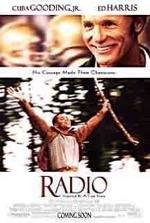
Starring: Cuba Gooding, Jr.
October 2003
“A Triumph of the Human Spirit”
Using the word triumph to describe Radio is no overstatement. Radio delivers on everything it promised in the emotional trailer, plus a great deal more. It’s a genuinely touching story that boasts Oscar-caliber performances by Oscar-winning actors, Cuba Gooding, Jr. and Ed Harris.
The plot isn’t complicated, flashy or filled with mind-blowing twists, but its straightforward simplicity is its greatest attribute. The story is pure and innocent, qualities the title character can readily identify with.
The story takes place in 1976 in a small town in South Carolina, where head football coach, Harold Jones (Harris) spots an odd young man (Gooding, Jr.), who pushes around an old shopping cart that contains various collected items (including a football belonging to Jones’ team). Jones takes interest in the young man and enlists his help on the football team, much to the disapproval of the team, school and community. Jones stands his ground and, over time, becomes a surrogate father for the mentally handicapped youth, whose infectious affection for all styles of music earns him the nickname, “Radio.” What ensues is a journey of self-discovery for both men in this heart-warming tale of human kindness, based on a true story.
Though sports have an important role in the film, this isn’t Remember the Titans or Hoosiers. Whereas sports is the vehicle for telling the story, Radio is all about the flesh and blood characters that breathe life into what otherwise would have been just another modernized re-telling of a glorious championship season of the past.
The pacing of the film is a bit slow at times, but this effect lends itself to the sleepy burg atmosphere of the southern town, and other than this aspect, the directing and writing is very solid. For Radio, James Horner has churned out an original score that is more original than his usual, cookie-cutter drivel (Sneakers, Bicentennial Man and A Beautiful Mind are all virtually the same score), while employing the same ethereal voices in certain motifs.
Radio is a winner because it refuses to lampoon the disability of the mentally challenged lead character, but instead, shows how, in many ways, he is more human than the rest of us “normal” people. Showing clips of the real-life Radio and Coach Jones at the end of the movie was a very nice touch. Radio is an inspiring film that is definitely worth tuning into.
Rating: 3
Runaway Jury (PG-13)

Starring: John Cusack
October 2003
“Taut Thriller with a Good Moral”
Runaway Jury is the latest in a series of John Grisham novels adapted for the silver screen. Runaway Jury is every bit as intense as The Firm and The Pelican Brief, and, like its predecessors, boasts an all-star cast. The word that best sums up the movie is “paranoid.” Everyone in the film seems to be paranoid, and that persistent, pervading emotion soon rubs off on the viewer; you’re never quite sure who is on what side until the very end, which makes Runaway Jury a Grade A legal thriller.
The story begins with a disgruntled employee, recently terminated, returning to his workplace and opening fire on all of his former co-workers. Flash forward to the trial: Wendell Rohr (Dustin Hoffman) is the prosecutor for the plaintiff, a woman widowed by the shooting. Assisting the defense is Rankin Fitch (Gene Hackman), a no-nonsense, self-assured agent who is in league with the gun company that made the weapon used in the shooting. The gun company pays off Fitch to buy a verdict, so he immediately goes to work in his underground intelligence complex, where a full-time staff of highly-trained individuals utilizes high-tech equipment in order to spy on potential jurors. Based on profiles and other Intel, Fitch guides the defense attorney through the jury selection process, weeding out anyone who might be a threat to the verdict they desire. The jury is selected, but unbeknownst to Fitch, someone knows what he’s up to and has placed a wild card in the jury, someone with enough influence and charisma to swing the jury one way or the other. The wild card is Nicholas Easter (Jon Cusack), and his girlfriend, Marlee (Rachel Weisz), is the one who is throwing a monkey wrench into Fitch’s plans. She presents a deal to Rohr and Fitch—a promise to swing the jury their way for a price. Rohr has integrity and refuses the deal, but Fitch, hell-bent to win at any cost, agrees to pay Marlee. This decision sets a series of events into play that leads to a major twist and unexpected verdict.
Runaway Jury is a riveting tale that owes a lot to its rich source material. Beyond the intricate plot, the acting is nothing short of stellar and features the first big screen appearance of long-time friends, Hackman and Hoffman. The scene they share is absolutely electrifying; both men engage in a war of words that is unrivaled in recent motion picture history. Cusack is very good in his everyman role as Nicholas Easter and the rest of the supporting cast does a phenomenal job, especially Jeremy Piven as Rohr’s assistant.
There’s a great David vs. Goliath moment at the end of the film, where men and women of good conscience stand up to the greedy gun company. The movie has a good moral and a great message, but the jury is still out as to how well it will do at the box office.
Rating: 3
Intolerable Cruelty (PG-13)

Starring: George Clooney
October 2003
“Undeniable Stupidity”
Intolerable Cruelty truly is the best phrase to describe this film, because, after fifteen minutes of watching this mind-numbing display of unbridled avarice and over-the-top acting, you’re ready to sign your life away just to get out of the theater. George Clooney plays shifty divorce lawyer, Miles Massey, who never looses a case until he looses his heart to his kindred spirit, Marilyn Rexroth, an alluring divorcee portrayed by Catherine Zeta-Jones.
As the movie progresses, it gets zanier by the minute as Rexroth leaves behind a trail of affluent, but easy-to-dupe husbands who make her filthy rich with prenups. As kismet would have it, Massey marries Rexroth, and, in a display of undying love, he rips up the prenup. on their honeymoon night. Rexroth betrays Massey, of course, and leaves him lovelorn and homicidal; but in the end, she comes to her senses and decides to return to Massey. And they live happily ever after…or something like that.
Intolerable Cruelty leaves you searching for a meaning behind its quirky and murky plot. It flirts with a message (love’s supremacy over the lust for money), but the story is so muddied by ambition, deception and shady morality that anything virtuous is undetectable when looking back on the film as a whole.
There’s a ton of foul language in the movie and the dialogue, when clean, is excessively stilted, employing quotes from Shakespeare and other literary giants in order to convey basic concepts. This renders the movie verbose, trite and unreachable. The movie tries to be funny, but it fails miserably—like the “sitting before the judge before” scene with Edward Herman as the cornball, Mr. Rexroth.
The major problem with the film is its lack of a protagonist—Massey’s exploits are hardly laudable and Marilyn Rexroth is a manipulative minx. And we’re supposed to cheer when they finally get together? What were Clooney and Zeta-Jones thinking when they accepted this script? Intolerable Cruelty is a terrible waste of star power and an egregious waste of time.
Rating: 1 1/2
Out of Time (PG-13)
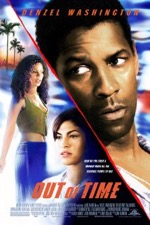
Starring: Denzel Washington
October 2003
“Thrill a Minute With a Touch of Humor”
Denzel doesn’t disappoint. Not much of a revelation, I know, but you would think that somewhere along the way, the Academy award-winning actor would trip up and select a project that would miss its target. In the early stages of the film, I thought this might be just such a time; the movie was very slow out of the starting blocks and featured Denzel, playing the chief of police in a small, shoreline town in Florida, in the throes of a divorce while messing around with another man’s wife—very uncharacteristic of the actor who’s brought us so many heroic roles in the past (Crimson Tide, The Pelican Brief, Remember the Titans and Antoine Fisher just to name a few).
Denzel’s Matt Whitlock makes one bad choice after another in the film’s prologue; he plans to steal away with his steamy paramour—who claims to be the victim of both an abusive husband and a fatal form of cancer—by using evidence money from a recent drug bust that had elevated his status to local hero. When Whitlock’s mistress and her husband are killed in an arson fire—and he’s spotted at the scene of the crime, events spiral downward at an alarming pace.
Putting out one brushfire after the next, Whitlock attempts to discover who framed him, while keeping his own police department and the feds. off balance just long enough for him to find the evidence that will exonerate him. After a series of nail-biting episodes in which Whitlock’s indicting affair is nearly revealed, and several genuine, on-the-edge-of-your-seat action sequences, Whitlock discovers the mastermind behind the elaborate trap and realizes that he may have committed one mistake too many.
As mentioned, Denzel is pitch-perfect as the protagonist, but he is surrounded by some wonderful talent, not the least of which is Dean Cain (Lois & Clark) as the rival husband, Sanaa Lathan as Whitlock’s mistress, Eva Mendes (2 Fast 2 Furious) as his estranged wife and his delightfully quirky side-kick, played by John Billingsley (Star Trek: Enterprise), who delivered the most memorable line in the movie, “A beer in hand is worth two in the fridge.”
It probably won’t go down as movie of the year in any category, but Out of Time is a great popcorn flick that entertains and raises the blood pressure all at the same time.
Rating: 3
Under the Tuscan Sun (PG-13)

Starring: Diane Lane
September 2003
“Average Romance Shot in Timeless Tuscany”
Under the Tuscan Sun is a heartwarming romance that, mercifully, balances out the love story with artistic and dramatic panache, along with touching moments of genuine humanity. The movie’s success can be attributed to Diane Lane’s wonderfully organic performance and to the awe-inspiring Tuscany countryside which serves as breathtaking backdrop and nonhuman star in the film. Audrey Wells directed the movie and also wrote the screenplay, which is based on the memoirs of Frances Mayes.
Recently divorced, Frances (Lane) gets a wild hair and decides to relocate to Italy. Purchasing a modest home in a Tuscany villa, Frances finds the time for artistic pursuits as well as hosting parties when not renovating and maintaining her casa. After her heart has had the proper time to heal, Frances visits the coast and finds the man of her dreams—but even the perfect man, Frances learns, has his share of sordid secrets.
The movie’s pacing can make an insomniac drowsy, but Lane skillfully chews enough scenery to hold the audiences’ attention; the unconventional love story further aids in sustaining viewer interest. Under the Tuscan Sun is made memorable by the stunningly scintillating location work, but also by the uplifting story about a courageous young woman who ends one chapter of her life and boldly begins a new chapter on a different continent. Hope springs eternal…especially in idyllic Tuscany.
Rating: 2
Secondhand Lions (PG)
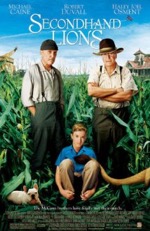
Starring: Haley Joel Osment
September 2003
“Come See This Comely Coming-of-Age Tale Firsthand”
Secondhand Lions, a lighthearted tale of self-discovery, focuses on prepubescent Walter (Haley Joel Osment) and his two eccentric uncles, Garth (Michael Caine) and Hub (Robert Duvall).
The movie opens with Walter’s promiscuous mom (Kyra Sedgewick) dumping him off at his uncles’ farm for the summer while she goes off to “get a job” (translation: have a wild time) in Vegas. Garth and Hub’s daily routine involves sitting on a porch swing with rifles and taking potshots at any salesperson bold or foolish enough to approach their farmhouse. Appalled by their declared open season on salesmen, Walter challenges his uncles to find out what the peddlers are selling before filling their britches with buckshot and to spend some of their rusting fortune on items of interest.
Taking Walter’s advice, Garth and Hub purchase a secondhand lion, which they intend to hunt in a nearby cornfield. When the lion arrives, however, they discover that this king of beasts is docile and has one paw in the grave. Dispirited, the aging men feel even more obsolete than before; hunting a lion would have transported them back to the glories of their youth when they fought in wars and lived life on the edge. By summer’s end, Walter’s uncles teach him how to become a man and Walter teaches his uncles how to enjoy life again by being more spontaneous.
Caine and Duvall deliver superlative performances and Osment continues to amaze with the depth and maturity of his craft for one so young. Though Josh Lucas, as the adult Walter, looks nothing like Osment, the movie’s wrap-up is heartwarming and has an excellent payoff. Secondhand Lions is a family-friendly drama that deals with coming-of-age and old age in a meaningful, yet whimsical, manner. It’ll probably fly under the radar, but this is one film that shouldn’t be missed.
Rating: 2 1/2
The Fighting Temptations (PG-13)
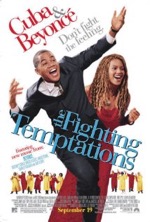
Starring: Cuba Gooding, Jr.
September 2003
“A Class Act, But No Sister Act”
Darrin Fox (Cuba Gooding, Jr.) is a fast talker who manages to work his way up the ladder to an enviable position at a marketing firm in New York City. Just when things are going great in his life, Darrin receives news that his beloved aunt has passed away. Returning to his hometown of Montecarlo, GA—the quintessential southern burg—Darrin is reunited with friends and family, whose speech, clothing and habits throw him into immediate culture shock; his roots have come back to haunt him.
Darrin stands to gain a great deal of money from his aunt’s will, but her dying wish contains one condition—Darrin must conduct the Baptist choir and win the annual music contest in order to receive his inheritance. Darrin, who knows next to nothing about music (but can fake his way through anything), is dealt a bad hand from the start; the choir contains half a dozen average vocalists, a wizened organ player and a controlling pastor’s wife who resists him at every turn.
Darrin enlists the help of his childhood sweetheart, Lilly (Beyonce Knowles), who has the voice of an angel, but according to the pastor’s wife, sings the devil’s music in the local bar. This is just the first of many obstacles Darrin must hurdle in order to build a choir and get it ready for the competition. When circumstances go from bad to worse, Darrin tucks tail and heads back to his comfortable life in the Big Apple. But he soon realizes it’s not about the money anymore; it’s about the relationships he’s built with his choir and the commitment he made to them and his departed aunt. Darrin returns with a newfound passion and leads his group in a rousing number at the competition. If you’ve seen Sister Act, you can guess the end from here.
And speaking of Sister Act, there are more than just a few similarities between that breakout blockbuster and The Fighting Temptations, but this new version of the “average church choir wins the big music competition” plot doesn’t hold a hymnal to the Whoopi Goldberg comedy classic. Cuba Gooding Jr. is believable in the way he gradually comes around, leaving behind his big city attitude and reverting to the caring and honest person he was in his youth. Beyonce Knowles hits her marks and says her lines, but it’s clear that her incredible voice is the only reason she’s in the movie.
There are some wonderful cameos in the film: Steve Harvey’s radio D.J. provides several moments of hilarity and the Rev. Shirley Caesar and rapper T-Bone lend their talents to the final show-stopping number. And let’s not forget the men in the orange jumpsuits—the inmates that Darrin recruits for his makeshift choir. Some of the movie’s funniest moments involve these upstanding (though cuffed) choir members.
The Fighting Temptations isn’t the greatest movie of its kind, but it is inspiring and features some toe tapping, head-bobbing and smile-raising Gospel music.
Rating: 2 1/2
S.W.A.T. (PG-13)
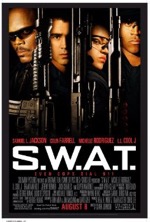
Starring: Samuel L. Jackson
August 2003
“By the Book Update of 70’s Police Drama”
S.W.A.T. is an acronym that stands for Special Weapons and Tactics. S.W.A.T. is also the name of a short-lived television series that ran during the 1975-1976 season and starred Steve Forrest and Robert Urich. The new S.W.A.T. movie has barrowed many of the names and archetypes from the original show, but has wisely transported the setting forward several decades and given the story an appropriately edgier tone.
In some respects, S.W.A.T. is little more than a glorified TV show with big-name actors, and this should come as no surprise since the movie’s director, Clark Johnson, is best known for his work on small screen hits like Homicide: Life on the Street and The Shield. Even though the movie closely resembles a standard police procedural, it’s still considerably better than it would have been had the producers committed the cinematic crime of adopting the style and milieu of the TV series: 70’s crime dramas were notorious for depicting police officers merely as caricatures of real cops, as virtual superheroes who were impervious to error, corruption or bullets.
Here, thankfully, the characters are a little more three-dimensional, if a little doughy in the middle. Samuel L. Jackson portrays hard-nosed Sgt. Dan “Hondo” Harrelson and Colin Ferrell plays debased officer, Jim Street, a man who desperately strives to earn Harrelson’s acceptance and thereby find redemption for a past mistake that has tarnished his record and reputation. In the Sydney Bristow era, it’s become a prerequisite for an action movie to feature at least one gorgeous, butt-kicking chica, and in S.W.A.T. we have Michelle Rodriguez (The Fast and the Furious), who embodies the tough-as-nails officer, Chris Sanchez. Rounding out the cast is LL Cool J as Deacon “Deke” Kay and Olivier Martinez as French baddie, Alex Montel, a loathsome tycoon who offers a $100 million reward to anyone who breaks him out of prison.
Most of the movie’s action scenes are similar those you’d see on primetime TV with one major exception…the heart-stopping sequence where Montel’s plane crash-lands on a four lane bridge and bullets start flying like snowflakes in a blizzard. Though I had hoped to see more scenes of this caliber throughout the movie, this pulse pounding sequence is, by itself, worth the price of admission. All things considered, S.W.A.T. is an admirable attempt at graduating a TV series to the big screen and features gritty realism, believable characters and a sobering reminder of how law enforcement officers all-too-frequently pay the price for our enduring security and freedom.
Rating: 2 1/2
Freaky Friday (PG)

Starring: Jamie Lee Curtis
August 2003
“Modern Remake Lacks Heart”
As far as remakes go, this was an entertaining, if uninspired, effort. The main question that preoccupies the film isn’t whether or not Freaky Friday is better than the original, but why it was necessary to update it at all. The first Freaky Friday, with Barbara Harris and Jodi Foster was wildly entertaining and deserved the right to become a stand-alone classic. Music/hair/clothing styles have all changed over the years, but other than modern trappings, this new movie is virtually identical to its “groovy” predecessor.
The movie opens with the classic mother vs. daughter battle, which escalates at a Chinese restaurant. The Asian proprietor slips the arguing pair two fortune cookies, which magically switches the mother’s soul into the daughter’s body, and vice versa.
A lot of gags ensue the next day as the two women try to switch back (by running and slamming into each other), and when Annabel’s mother, Ellen, goes to school while Annabel embarks on a shopping spree with her mother’s credit cards. These fish-out-of-water scenes (like when Ellen dresses like her daughter and hitches a ride on a motorcycle, or when Annabel destroys the psyches of her mom’s mental patients), become the meat of the story, but it’s not until the two women make peace and show respect to each other that the farcial curse is finally broken and the film comes to a heart-warming climax.
There’s a lovely scene at the end of the film where Annabel thinks of Ellen’s happiness before her own, and gives her blessing to her mother’s union to her new stepfather (Mark Harmon). It’s the only point in the film that I emotionally connected with the characters and thought that, just perhaps, there really was a story amid the flowing fountain of fluff.
The acting in the movie was solid enough; Jamie Lee Curtis was convincing as the uptight, killjoy, Ellen, and Lindsey Lohan (The Parent Trap) was pitch-perfect in her portrayal of a modern teenage girl who wages an emotional tug-of-war with her overbearing mother.
There’s no doubting that this new Freaky Friday is a load of good, clean fun, which will introduce a new generation to this “trading places” tale. But, in the final analysis, the original had more charm than this modern update.
Rating: 2 1/2
Seabiscuit (PG-13)
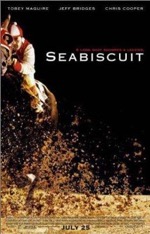
Starring: Tobey Maguire
July 2003
“A Truly Inspirational Triumph”
The only word that readily comes to mind when reflecting upon Seabiscuit is “exquisite.” This is an exquisitely crafted, directed, acted and written film. Based upon the true story and the popular book by Laura Hillenbrand, Seabiscuit tells the story of three individuals and how their lives eventually intersect in wonderful, and sometimes unexpected, ways.
The story picks up in 1910, a time of prosperity for Charles Howard (Jeff Bridges), entrepreneur and car salesman. Life suddenly takes a left turn when his young son drives one of his cars off the cliff and his wife leaves him a short time later. Charles looses nearly everything when the Great Depression hits—no one can afford to buy cars anymore.
But, Charles’ luck changes when he takes a vacation to Mexico; he meets a new woman at the horse races and wins her heart along with a lot of cash. Charles’ life is forever changed when he meets hotheaded jockey, Red Pollard (Tobey Maguire) and an old, eccentric horse trainer, Tom Smith (Chris Cooper), outside the horse track. Converting his car shed into a stable, Charles forges ahead in a new business venture and begins racing Red on a horse named Seabiscuit. They win some small-time races, but Charles has his sights set on bigger prey; he baits the owner of War Admiral, one of the fastest horses in the country, into racing against Seabiscuit—the contest is akin to David and Goliath (or the Tortoise and the Hare). So Charles enters the high-stakes race with a horse that’s too short, a jockey that’s too tall and a trainer that’s too old. The race is one for the history books…truly inspiring.
The writing and directing is exceptional in Seabiscuit, but the acting is nothing short of stellar. Jeff Bridges plays salesman Charles Howard to the hilt; the man is so charismatic and charming, he could probably sell a rancher his own cow. The speeches he delivers are so rousing and ennobling that you have to resist the urge to jump up in the theater and yell in agreement.
Chris Cooper (my vote for best supporting actor-2003) is so natural, so likeable and so pitch-perfect in his performance, that it’s impossible to see any other actor in his role. His character is the sage in the movie, delivering didactic delicacies like, “Just because something’s broken doesn’t mean you throw it away.”
If Cooper represents the movie’s wisdom and experience, Tobey McGuire is its heart and soul. Fresh off his Spider-Man high, McGuire’s turn as the tortured jockey is believable and touching. Horse and rider both know a thing or two about pain and that background of brokenness is the common bond between man and animal. It’s this brand of empathy that makes the pair so in tune with each other and so formidable on the track.
The quirkiest, most hilarious character in the movie, undoubtedly, is William H. Macy’s radio announcer, whose flair for mile-a-minute speaking, incisive one-liners and variety show sound effects really lightens the otherwise somber and serious tone of the film. Though his screen time is limited, Macy’s performance is also worthy of Oscar consideration.
Framing the movie historically are snippets of David McCullough’s Seabiscuit documentary for PBS. These historical vignettes, interspersed throughout the movie, serve as segues but also give the film added depth and authenticity. A finely crafted film, Seabiscuit is an emotional journey well worth taking.
Rating: 3 1/2
Lara Croft Tomb Raider: The Cradle of Life (PG-13)
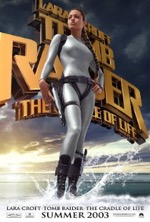
Starring: Angelina Jolie
July 2003
“Second Time Isn’t the Charm”
There’s an old saying: “Fool me once, shame on you. Fool me twice, shame on me.” I’m ashamed to say, that for the second time, I fell for Tomb Raider’s alluring promise of a summer blockbuster that would thrill and entertain. The movie did neither.
The prize of great worth this time around is Pandora’s Box, which will reveal the origins of life on earth when opened. In a plot that mimics the other Raiders with Harrison Ford, but has none of the panache of that action/adventure classic, Lara Croft seeks an amber orb that will reveal the location of the mysterious “Cradle of Life,” the resting place of the mystical Pandora’s Box.
As the story would demand, the orb falls into the wrong hands, but Croft recovers it and kicks the villain into a pool of acid. The only twist: her new hunk decides he wants to open Pandora’s Box, and ultimately, Croft has to kill him to prevent the history of the universe from being tampered with; she resists the urge to open the box, something the fabled Pandora couldn’t. What a hero that Lara Croft is!
As mentioned earlier, the plot is so contrived, that the movie almost becomes a parody of itself, treating myth as fact and creating its own reality in the process. The action sequences were a bit blasé, even when compared to the original Tomb Raider, and most of the dialogue could have been delivered more expressively by cardboard stand-ups.
If there’s anything positive in the film, it’s that Croft’s outfits aren’t as skimpy and gratuitous as in the last film, and with the exception of a brief bedroom vignette, Tomb Raider is a fairly clean movie; if not a bit graphic at times.
So, now the question is, “Will there be another Tomb Raider, or will the franchise become just another archaeological oddity?”
Rating: 1 1/2
The League of Extraordinary Gentleman (PG-13)

Starring: Sean Connery
July 2003
“More than Ordinary, Less than Extraordinary”
I’m just going to go ahead and admit it: I’m a sucker for this kind of movie. One of my favorite comedies of all time, Mystery Men, is another example (though radically different in theme and tone) of this “hodgepodge of heroes” concept. There’s just something about a team of misfits coming together and using their various talents to kick the bad guy’s butt that just really appeals to me.
A masked villain, know as the Phantom, and his cronies, have been wreaking havoc in England and other parts of Europe, employing a fleet of über-tanks, automatic rifles, armored suits and flame-throwers; all impressive weaponry for the late 1800’s. To defend Her Majesty’s homeland, a team of amazing individuals is assembled, lead by the redoubtable—if slightly doting—Allan Quatermain (Sean Connery). In addition to the hunter extraordinaire, the team is comprised of Dorian Gray (Stuart Townsend), Mina “Vampiress” Harker (Peta Wilson), Captain Nemo (Naseeruddin Shah), the Invisible Man (Tony Curran), Tom Sawyer (Shane West) and Dr. Jekyll/Mr. Hyde (Jason Flemyng).
Once assembled, the team is immediately ambushed by the Phantom in Dr. Gray’s mansion. When met by overwhelming resistance by the League, the Phantom flees, and the chase is on. Aboard Captain Nemo’s submarine, Nautilus (one of the most creative elements in the film), we are allowed a glimpse into the minds of several characters, most notably, Dr. Jekyll/Mr. Hyde; a tortured figure that simultaneously produces fear and pathos in the viewer—he’s the most fully-realized character in the movie. After thwarting the Phantom’s plans to destroy Venice from below, the group discovers that the League is a sham and that Dr. Gray obtained blood samples from each member of the team on their voyage. The Phantom plans to clone the League and use their evil, alter egos to overthrow all of Europe. The real League arrive at a snow-covered island (the Invisible Man, who had stowed away aboard an enemy craft, leads the Nautilus to the villain’s lair), infiltrate the Phantom’s hidden facility (part factory, part lab), destroy their D.N.A. and polish off all the bad guys, but not before Quatermain is killed from a gun shot.
LXG is a solid hit, but it falls far short of a home run. The movie’s climax is heart stopping at times, but the wrap-up is contrived and utterly meaningless (unless the witch doctor raises Quatermain from the dead just in time for a sequel). Even with the disappointing dénouement, the biggest tragedy in the film is that it has so much unfulfilled potential. The depth and complexity of this alternate history, paired with fascinating characters and an overabundance of creativity should have amounted to a much finer end result. As things are, LXG is a summer popcorn flick that entertains, but fails to create a league of its own.
Rating: 2 1/2
Pirates of the Caribbean (PG-13)
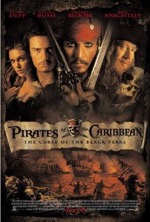
Starring: Johnny Depp
July 2003
“Slow to Sail, but Worth the Voyage”
You can almost smell cannon smoke, can almost feel the exhilaration of being in a sword duel and can almost feel the thrill of being on the open sea in Disney’s Pirates of the Caribbean. The key word here is “almost.” Pirates of the Caribbean is almost the swashbuckling adventure that you want it to be, but not quite. The plot takes a while to get out of the bay, and when it finally reaches open water, the few twists that exist in the script leave you with the feeling that you almost had a good time.
The movie opens with pirate Captain Jack Sparrow (Johnny Depp) scheming to steal a ship, while simultaneously attempting to give the Red Coats the slip. He crosses blades with Will Turner (Orlando Bloom), a blacksmith apprentice, and son of a notorious pirate. Will, eager to leave the blacksmith shop and become a pirate, joins Jack after the two strike up a tenuous friendship. The pair of pirates steal a British ship and pursue the grossly-fabled and greatly-feared, Black Pearl—a pirate ship with sails that look like Swiss Cheese and swabbies that turn into skeletons when bathed in moonlight.
The skipper of the Pearl, Captain Barbossa (Geoffrey Rush), is in pursuit of the last piece of gold that came from Cortez’ cache. The curse that holds Barbossa and his crew in a pseudo-limbo state—neither living, nor dead—will be lifted when the last medallion, covered with the blood of a member of a certain pirate family, is returned to the chest. After several ship battles and several sword fights, it is discovered that Will, son of infamous Bootstrap Bill, is the only one that can break the curse. Barbossa’s bony men ambush a British ship, which only has a skeleton crew aboard and make short work of the Red Coats (bullets don’t kill skeletons). In a climactic moment, when Barbossa and Jack are locked in an epic duel, Will cuts his hand and tosses the blood-spattered gold piece into the brimming treasure chest and Jack shoots Barbossa with his gun. Barbossa falls over dead, and at that moment, the tide is turned on the ship, where Barbossa’s crew is swiftly defeated.
Pirates of the Caribbean succeeds on several levels; the art direction and costuming is superb. The effects are great, as would be expected, and the acting is very good. In fact, Johnny Depp’s performance is so superior as the nutty, quirky, shifty Jack Sparrow (that’s “Captain Jack Sparrow,” thank you), that it’s no stretch to say that the movie would have flopped without him. Depp infuses the flick with a certain degree of irreverence and levity that would have been sorely missed in his absence.
Thankfully, the film is devoid of any sayings or references that are out of time or place (I call them Disneyisms), which have been employed far too often in most modern Disney movies. On the whole, the dialogue if fairly true to the time period it represents and is consistently humorous.
Pirates of the Caribbean is fun, summer entertainment that should please a large audience, even if it fails to deliver the best story possible. I guess dead men aren’t the only ones who can’t tell tales.
Rating: 2 1/2
The Hulk (PG-13)
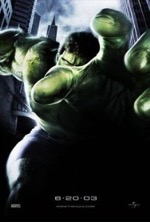
Starring: Eric Bana
June 2003
“Dark, Depressing, Distracting and Disappointing”
The Hulk is a big, jumbled mess that is so preoccupied with being the next big-screen sensation that it fails to entertain in nearly every way. Ang Lee’s avant-garde directing style is so distracting (relentlessly accosting the viewer’s eyes with a variety of wipes, split-screen or multi-panel effects), that it should be mandatory for the box office tellers to hand out two aspirin with each movie ticket.
This version of The Hulk is based on the comic book, not the 70’s TV show, and is the worse for it. In the TV version, Bruce Banner would transform into the Hulk if he broke his finger, or if he was attacked, or if he saw someone being victimized and “got angry.” In the movie, Bruce has no such catalysts for transformation; but becomes the Hulk when “repressed memories” (puh-leez) from his childhood trigger a physiological response and turn him into the not-so-jolly green giant.
The comic incarnation established that the Hulk has the ability to leap/bound three miles at a time, and whereas this is probably really cool on the page, it’s cheesy as heck on the silver screen. To make matters worse, the Hulk jumps from one mountaintop to another for close to five minutes, producing dizziness and thoughts such as, “Okay, I get the point already!” Another trait that doesn’t lend itself to the believability of the film is the Hulk’s immense size; he’s several feet taller than his comic book alter ego and simply looks too large.
The film’s pacing is excruciatingly slow, especially in the beginning, where the audience has to wade through nearly an hour of exposition before the Hulk’s first mutation, and most of the back-story is boring and confusing. Good storytelling involves showing, not telling, but The Hulk takes this principle to absurd extents…way too many things are left unexplained. Like, was there really a nuclear blast in the past or was that just a part of little Bruce’s horrific memories? Or, what in the world does David Banner turn into at the end of the movie (some kind of ectoplasmic balloon)?
If there’s a bright spot in The Hulk it’s the acting. Eric Bana is surprisingly convincing as the Hulk; he doesn’t allow over-emotionalism to stilt his performance. Jennifer Connelly is good as Betsy Ross, but her role certainly isn’t Oscar-worthy, and her on-screen father, General Ross, is played to the hilt by the rugged, no-nonsense, Sam Elliot. Nick Nolte portrays David Banner (or is he just playing himself?), a mad-scientist type who clearly has some mental and emotional issues to work through—kudos to the casting director.
The biggest failure in The Hulk is the disservice it pays to its target audience—young boys. The Hulk never once uses his super-human abilities for constructive purposes, but rather, destroys anything and everything in sight without the slightest consideration or compunction: there’s nothing heroic in the Hulk’s actions and he becomes little more than an oversized thug in the movie. Seething anger and unbridled hatred fuel this version of the Hulk, and as such, makes him a poor role model for kids.
The final word: as corny as it was, the 70’s TV show was infinitely more believable, and ironically, more entertaining than this new, unimpressive knockoff.
Rating: 1
Hollywood Homicide (PG-13)
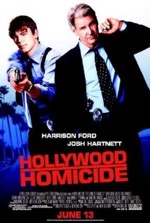
Starring: Harrison Ford
June 2003
“Glorified Cop Show Misses the Target”
Hollywood Homicide feels like a big-screen version of the new Dragnet TV series. Both are based in L.A., both feature cops working the homicide beat and both have a seasoned veteran and a young-buck sidekick. All of these similarities to Dragnet and other cop shows hamstring the picture, and any new and fresh ideas the writers hope to achieve seem trite by comparison.
The story begins with a murder at a dance club and the plot slowly unravels, linking the first murder to another double murder. As they investigate the case, Detective Joe Gavilan (Harrison Ford), who sells real estate on the side, tries to foist a lemon on anyone who will buy it, while his partner, K. C. Calden (Josh Hartnett), teaches a yoga class and schmoozes with every woman in sight. Joe engages in some unorthodox methods of investigation (one of his informants is a cross-dresser) and K.C. begins to consider a career in acting. The murders lead back to a local record producer, who evades the two detectives until he meets an untimely demise. An accomplice to the murders proves to be the man who killed K.C.’s father, and rather than taking revenge, K.C. records the man’s confession on a hidden cassette recorder. In the end, Joe sells the house and K.C. makes his acting debut. And they all live happily ever after—if that’s possible to do as a cop in L.A.
Hollywood Homicide takes an eternity to get going, and when it finally does, it doesn’t deliver all that big of a punch. Even by the second act, it’s pretty obvious who the killer is, and as a villain, the record producer is severely underdeveloped, and doesn’t really evoke the feelings of loathing or fear that a good antagonist should convey.
The last quarter of the movie is one big car chase and is embarrassingly reminiscent of an 80’s cop show. At first, it’s nice to finally see some action, but as the chase sequence drags on and on, the urge to look for stray Skittles on the floor becomes a viable alternative to the mind-numbing action on the screen.
The only novel idea in the movie is a cop selling real estate as a part-time job, an idea that gets worn out from overuse. And as for Ford, why did he select this role? His last few script choices have been average at best (Air Force One was his last big screen triumph). Here, he tries to be an action star, but doesn’t quite pull it off. He tries to be funny, but only lands about half of his jokes. And his cell phone in the movie is just downright annoying (beating the first few bars of the Temptation’s “My Girl” into the ground). Unlike some naysayers, I believe there’s still gas in the old Ford, but he needs to choose better films to act in (like the forthcoming Indiana Jones IV).
Hollywood Homicide is like a falling star in Tinseltown; it shows for two hours, but is gone in sixty seconds.
Rating: 2
The Italian Job (PG-13)
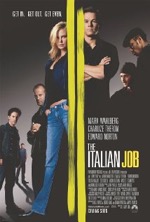
Starring: Mark Wahlberg
May 2003
“An Average Job, With Very Few Surprises”
“There is no honor among thieves.” The age-old saying proves very true in The Italian Job, an action-packed heist movie where routing for the bad guys is en vogue (because the other bad guys are much worse).
The movie begins with the thieves, led by Charlie (Mark Wahlberg) and John (Donald Sutherland), stealing a safe filled with 35 million in gold bars. The score goes down without a hitch until one of the members of the team, Steve (Edward Norton), double-crosses them, shoots John, takes all of the booty and kills the rest of the team (or so he thinks).
A year later, Charlie reassembles the original team (sans the deceased John) in L.A., with John’s daughter (Charlize Theron) thrown in for good measure, and they formulate a plan to get their gold back. Steve has purchased a plush mansion and has filled it with the dream items from all of the original team members (trophies that signify his conquest over them). Steve is smart and devious, but Charlie, with the help of his colorful and technical team, proves to be more than a match for the nefarious thief; and after a series of plot twists and action sequences, Charlie and his crew get their gold back.
The word that best describes The Italian Job is “average.” It’s not a bad movie, but it’s nothing revolutionary either; and Mark Wahlberg’s calculated under-acting only adds to the film’s mediocrity. The movie isn’t devoid of fun, however; the different members of Charlie’s team are quite entertaining, especially Lyle (Seth Green), a young man who claims to have invented Napster (he says his college roommate stole the program while he was asleep on his keyboard). Lyle fancies himself as “The Napster,” and is the technical genius of the group, deftly navigating his way through a self-made computer program that can hack into L.A.’s transportation system and re-route traffic anywhere he wants.
The team is assembled in an amusing, almost Ocean’s 11-like manner, but the moment is short-lived and most of the characters go unnoticed for the rest of the film. Edward Norton plays the perfect weasel-eyed villain and makes you want to reach through the screen and deck him in the face (like everyone else does in the film).
It’s not a complete loss, but in the final analysis, The Italian Job is a pretty average way to spend two hours.
Rating: 2 1/2
Finding Nemo (G)
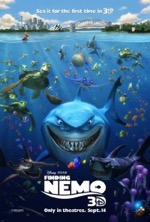
Starring: Albert Brooks
May 2003
“Disney/Pixar Goes ‘Down Under’ the Sea”
Disney’s stalwart animation studio, Pixar, is back in Finding Nemo, and this time they venture under the sea (sorry, no Sebastian this time). As would be expected, the computer-generated effects are jaw dropping and the detail and movement of the underwater creatures is really quite astonishing. The most striking element of Finding Nemo is the vibrant, almost three-dimensional colors that explode from every corner of the screen, like an underwater kaleidoscope.
Finding Nemo begins with a prologue section, which serves as a back-story and sets up the look and theme of the movie. Nemo (Alexander Gould) was the only surviving child of a barracuda raid, which took the life of his mother and turned his father, Marlin (Albert Brooks), into a paranoid and overprotective parent. Flash forward: Nemo, now in his formative, fish years, has none of his father’s hyper-cautious hang-ups and one day strays out too far from the reef. He is immediately captured by a diver and is later set free inside a dentist’s aquarium in Sydney.
Meanwhile, Marlin meets Dory (Ellen Degeneres), who suffers from an insufferable case of short-term memory, and the pair set out on a ponderous, arduous and dangerous journey to find Nemo. Back in the aquarium, Nemo makes some new friends and meets Gill (Willem Dafoe), who’s nearly died several times trying to escape the tank. Nemo is much smaller, however; and manages to stop up the water purifier and affect his escape (through a toilet bowl, of course). By now, the whole ocean knows of Marlin’s plight, and as soon as Nemo hits the open water, it’s only a matter of time before father and son are reunited.
The story is pretty standard fare for Disney, but what distinguishes Finding Nemo is its imagination; like the Sharks Anonymous club, or the minefield of jellyfish, or the copasetic turtles surfing along the East Australian Current. In Finding Nemo, the fish are humanized and the humans are drawn in bland hues with very little detail—there’s no doubting who the stars of the movie are.
Finding Nemo ends a bit abruptly and doesn’t deliver the big climax you would expect (imagine this: a school of barracudas show up right after the reunion and things look hopeless until the three sharks arrive and save the day), but it does leave you with the warm fuzzies. Though it flounders at times, Finding Nemo is a good family picture and should take a bite out of its competition (Sinbad) this summer.
Rating: 2 1/2
Bruce Almighty (PG-13)
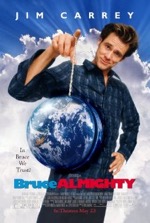
Starring: Jim Carrey
May 2003
“A Comedy That’s Heaven Sent”
What would you do if you were God for a week? This is the lofty question posed by the mildly irreverent, wildly entertaining Bruce Almighty. Bruce Nolan (Jim Carrey) is a disgruntled news reporter (the one who gets all of the boring human interest beats) who suffers one personal tragedy after the next. In one ill-fated day, Bruce looses his job, is beat up by a street gang, has a major fight with his girlfriend and wraps the front end of his car around a light post.
In an animated tantrum right out of the Carrey vault, Bruce takes out his frustrations on the Almighty, yelling at the sky such aspersions as, “the only one around here not doing his job is you.” Next day, Bruce is summoned to an abandoned factory and encounters God (Morgan Freeman), who gives Bruce His job. Bruce can do whatever he wants, but there is one catch: he can’t affect free will.
At first, Bruce takes devilish delight in paying back his enemies and using his newfound powers for personal gain, but he soon discovers that being God—even over a small section of Buffalo, New York—is a much bigger responsibility than he had previously imagined. In the end, Bruce surrenders to God’s will for his life and hands over the reins. Everything returns to normal; he gets his job and girlfriend back, but Bruce has gained a new perspective on life.
Though over-the-top in some instances, Carrey’s performance strikes an emotional chord in this film; he balances comedic silliness with some moments of genuine compassion and sympathy. Morgan Freeman is convincing in his portrayal of God (if not a little laissez faire), and Jennifer Aniston’s performance as Bruce’s girlfriend, Grace, serves as an anchor to the zany protagonist.
Bruce Almighty is a twist on It’s a Wonderful Life (a small clip of the classic movie even appears here), and presents a “what if” scenario that is quite engaging. What could have been a sacrilegious debacle is actually a faith-friendly flick in most respects and actually supports, rather than slams, a Judeo-Christian worldview. Bruce Almighty is a positive and entertaining movie experience; fun and faith affirming is a heavenly combo.
Rating: 2 1/2
X2: X-Men United (PG-13)

Starring: Patrick Stewart
May 2003
“Mutants Unite…and Go Nowhere”
As sequels go, X 2 succeeds on several levels—most notably with the addition of Nightcrawler (Alan Cumming) and a broader array of special effects—and has established the enduring comic mythos as a viable movie franchise. Clearly paving a path for another sequel (can you say, Phoenix?), X2 has all of the requisite action sequences and pyrotechnics necessary to achieve blockbuster status. But, amid the media hype and fan fervor, a question arises: “Is the sequel as good as the movie it evolved from?”
At the end of the first X-Men movie, Professor Charles Xavier (Patrick Stewart) boldly states to his one-time-friend and archenemy, Magneto (Ian McKellen), that he pities anyone who “comes to that school looking for trouble.” The school in question is the good professor’s academy for gifted youngsters, and someone does show up—with several dozen special ops. troops—and kidnaps a few of the young mutants. The mastermind of the attack is Stryker (Brian Cox), a retired military genius, who later abducts Prof. X and hatches his plot to annihilate all of mutant-kind. Along the way, we discover that fan-favorite, Wolverine (Hugh Jackman), was actually physically altered (implanted with adamantium plating) by Stryker, who unleashes Lady Deathstryke (Kelly Hu) on the lupine warrior, and a whirlwind battle ensues between Wolverine and Stryker’s newest creation. Multiple melees erupt in the film’s climax; a dam breaks, a X-man defects to the dark side and a X-woman meets an untimely demise.
All in all, X2 is an action-packed movie with some cultural relevance and a few moments with a human connection. The “Gee Whiz” factor is quite high on X2, but it fails to capture the clarity and intimacy of the original. The greatest contributor to this problem is the ever-growing pantheon of mutants. My biggest contention with the Batman films was the way the producers/writers packed the sequels with multiple villains, effectively splitting the audiences’ attention, and thereby, diminishing the impact of the antagonists. Here, the movies are overstuffed with good guys—keeping track of names, powers and current locations of the heroes becomes a chore even for the aficionados among us. And ultimately, despite all of the movie’s thrills, chills (Iceman) and spills, X2 never really goes anywhere, but merely opens the door to another chapter in the continuing war between humans and mutants.
X2 is popcorn entertainment that adequately moves the series forward, but hopefully the next mutation will involve a better script.
Rating: 2 1/2
Holes (PG)

Starring: Shia LaBeouf
April 2003
“Disney Digs up a Gem”
Every once in a while, Disney produces an entertaining, clean, live-action film that makes a hole in one. Though dissimilar in theme, last year’s, The Rookie, would certainly fit into this traditional, inspiration movie mold. This year’s model, Holes, is definitely something new under the sun; and in a summer swarming with sequels, it’s nice to see something fresh and innovative.
Based on the teen novel by Louis Sachar, Holes features an array of new talent, most notably, Shia LaBeouf as Stanley Yelnats and Khleo Thomas as Zero. There are also some other, more recognizable names here, like Sigourney Weaver as the camp warden and Jon Voight as the trigger-happy, sunflower seed gulping, Mr. Sir. The film is also bolstered by a solid screenplay and deft direction by Andrew Davis (The Fugitive).
Men in the Yelnats (Stanley spelled backwards) family have endured a curse for several generations. Young Stanley is in the wrong place at the wrong time and ends up a Camp Greenlake, a juvenile detention facility. To build character, these young men must dig holes all day in the oppressive desert heat, while avoiding snakes, scorpions and the deadly yellow-spotted lizard.
While digging, Stanley discovers an artifact that has an intricate and sordid past—a past that is fleshed out in several historical vignettes that occur at irregular intervals during the middle of the story and serve as an intriguing subplot. Stanley must unravel the mysteries of the past in order to break the familial curse and clear his name.
Holes doesn’t take itself too seriously, and yet, you don’t have to suspend your disbelief to dizzying heights in order for the fictional elements to make sense or feel like they fit in with the overall plot. The movie has a surprisingly solid storyline, and for a movie geared for teens, has far fewer plot holes than most adult movies.
Holes is as refreshing as a rain shower on a hot summer afternoon—an image not lost on the movie—and is a feel-good family flick that anyone can easily dig.
Rating: 3
Anger Management (PG-13)
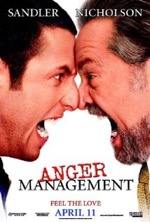
Starring: Jack Nicholson
April 2003
“Somebody Call the Script Doctor…This Film Needs Therapy”
Whenever I watch this brand of movie, I always have to stop and ask myself, “Do people like this really exist?” I suppose they do; archetypes this clearly defined aren’t created in a vacuum…or a test tube. And yet, I’ve never known anyone as easily enraged as Dave Buznik (Adam Sandler) or as certifiable as Dr. Buddy Rydell (Jack Nicholson). The movie’s casting was a no-brainer: Sandler excels at playing selfish, mad-at-the-world types and nobody does psychotic better than Nicholson; together, they’re a disturbing riff on The Odd Couple.
Dave is a mild-mannered businessman who bottles up everything inside and avoids conflict at all costs. In an uncharacteristic act, Dave looses his temper on a jet and later faces charges for his outburst—in order to avoid jail time, he must attend counseling sessions. Buddy, an anger management expert, is assigned the task of rehabilitating Dave, who, of course, claims he doesn’t have an anger problem…that all changes when Buddy’s unorthodox methods start to grate on Dave’s nerves. After finding Dave to be an “extreme” case, the court grants Buddy’s request to move in with Dave so that the psychologist can keep a closer eye on his patient. This doesn’t sit well with Dave or his girlfriend Linda (Marrisa Tomei), and that’s when, as they say, the defecation hits the rotary oscillator.
You’ve seen this movie before…it’s called What About Bob? and stars Bill Murray as a needy patient who stalks his vacationing psychiatrist, Richard Dreyfuss. The roles have been reversed and Buddy’s counseling strategies actually have some merit, but the two plots, at their core, share more than just a passing resemblance. Unfortunately, the same virus that afflicted What About Bob? has also infected Anger Management; namely the unrelenting torrent of screwball humor, melodramatic performances and a plot that borders on the absurd. Dave and Buddy are so dysfunctional that the majority of “normal” audience members will find it hard to identify with the deranged duo, much less sympathize with them. And just who exactly is supposed to be the protagonist here?
Director Peter Segal and writer David Dorfman have offered up a soulless story that flirts with salience but fails to deliver the smallest morsel of meaning. An even larger disappointment is that the movie—a supposed comedy—isn’t even all the funny. The best exchange in the film comes when Dave and Buddy are lying side by side in bed. Buddy offers, “In Europe, it’s not considered unusual for three or more men to share a bed,” to which Dave replies, “That’s why I’m proud to be an American.”
For the updated Miracle on 34th Street (1994), 20th Century Fox, confident they had produced a hit, offered a money back guarantee to disappointed attendees. Why can’t they ever make that kind of offer for a movie like this? After sitting through two hours of Anger Management, I was definitely mad enough to ask for my money back!
Rating: 2
Evelyn (PG)
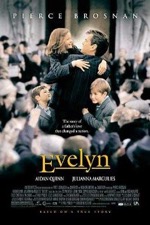
Starring: Pierce Brosnan
March 2003
Amid the deluge of effects-heavy pictures, comes little Evelyn, which marches up to those other movies like David accosting Goliath—an image not lost on this true story of a courageous father who took on the Irish Supreme Court to regain custody of his three children. Brosnan is wonderful in this family affirming and heartwarming tale.
Rating: 3
Gods and Generals (PG-13)

Starring: Stephen Lang
February 2003
Jeff Daniels, Stephen Lang, Robert Duval, Mira Sorvino, Kevin Conway, C. Thomas Howell, Bruce Boxleitner, Billy Campbell; the list of fine actors in the excellent ensemble cast goes on and on and on…much like the movie itself. Weighing in at three hours and forty-five minutes, Gods and Generals is, perhaps, too painstaking in its attention to historical detail—the pacing is a somnambulating lumber and huge sections of the story consist of exceedingly dry narrative. Under Ron Maxwell’s direction, the movie feels like a high-dollar documentary, lacking any kind of synergy; even the paint-by-numbers battle sequences are static (the only exception is when Daniels’ Lt. Col. Chamberlain is prone on the battlefield, frozen in fear as cannon balls and wounded soldiers fall around him all night long). All of Ted Turner’s money (and even a cameo by the financial mogul) couldn’t hoist the movie out of the slough of mediocrity. By movie’s end, I didn’t care which side won the battle; I just wanted a good, long stretch and some fresh air.
Rating: 2
Daredevil (PG-13)

Starring: Ben Affleck
February 2003
The “devil” part is dead on—this character is no hero, seeking his own brand of justice and crossing the line (homicide) that other “true” heroes in the mold of Batman would never entertain, much less tolerate. Character development is as scant as Garner’s outfit and the fight scenes lacked emotional impact.
Rating: 1 1/2
Shanghai Knights (PG-13)
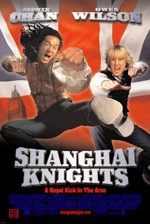
Starring: Jackie Chan
February 2003
Shanghai Knights begins a bit slowly, but picks up the pace when Roy and Chon reach London. There are many amusing twists on historical figures in the film, but too many of the fight sequences are like baby's bottoms. It will be interesting to see which continent the duo lands on in Shanghai Dawn.
Rating: 2 1/2
The Recruit (PG-13)
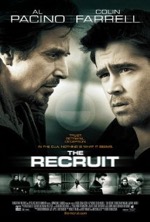
Starring: Al Pacino
January 2003
The Recruit is a solid spy movie that utilizes action sequences and plot twists to the hilt, while leaving the characters a bit underdeveloped. Pacino and Farrell are believable, if not amazing, in their roles. The only downside to the climax is that it leaves you scratching your head on the way out of the theater.
Rating: 2 1/2
The Hours (PG-13)

Starring: Meryl Streep
January 2003
Based upon the life and works of Virginia Woolf, The Hours focuses on the themes freedom and love and the issues of suicide and homosexuality. Under solid direction, Kidman, Moore, Streep and (especially) Harris are absolutely brilliant, but the movie is so moody and depressing, it fails in its attempt at being life-affirming.
Rating: 2 1/2
Antwone Fisher (PG-13)
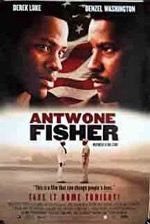
Starring: Derek Luke
January 2003
Denzel Washington’s directorial debut is—was there any doubt—a great piece of cinema. Based on a true story of the title character’s life, Antwone Fisher reveals the challenges of dealing with a painful past and the courage one can find when confronting those issues. Despite some heavy subject matter, Antwone Fisher is a triumph.
Rating: 3